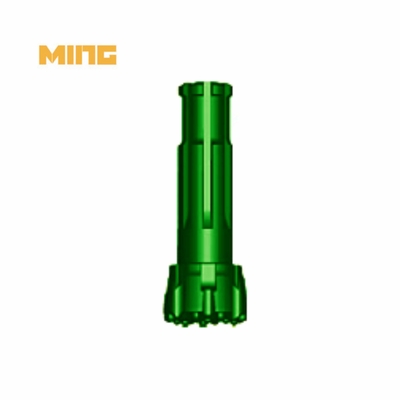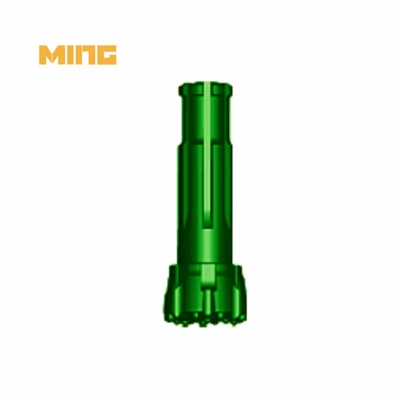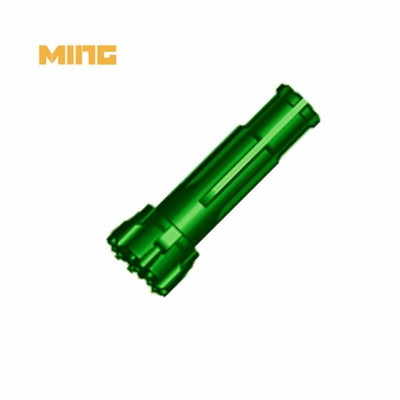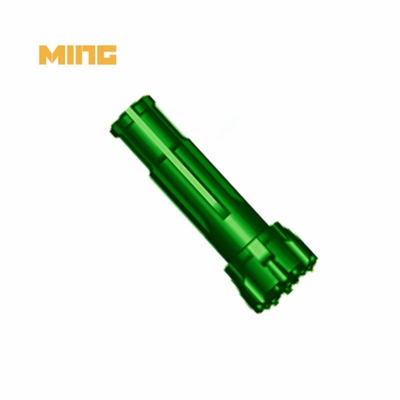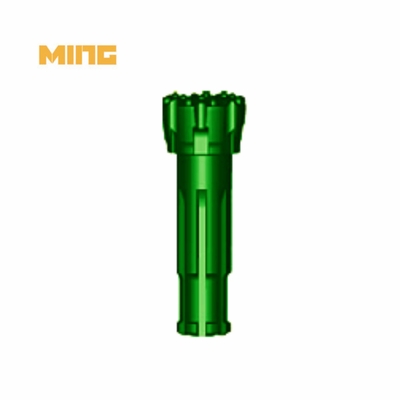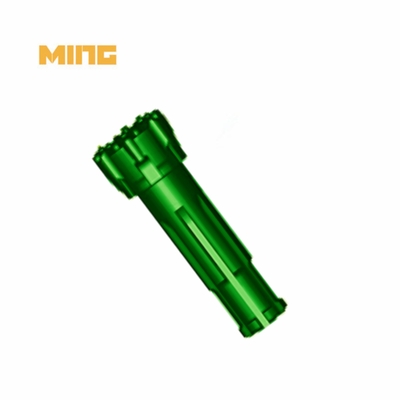Product name: 127mm PR4 Down The Hole DTH Reverse Circulation Drill Bits For Underground Drilling Rig
Product category: DTH drill tools
Diameter: 127 mm
KINGDRILLING high air pressure DTH button bit description:
Reverse circulation drilling, is a widely used method in the mining and exploration industry for obtaining samples from deep within the earth. In this technique, a pneumatic hammer is used to drive a tungsten-steel drill bit into the ground, creating a borehole. The cuttings are then brought to the surface through the center of the drill rods, which circulate in the opposite direction to traditional drilling methods. Reverse circulation drill bits play a crucial role in this process, as they are specifically designed to efficiently collect and transport drilling samples to the surface. In this detailed guide, we will delve into the world of reverse circulation drill bits, exploring their advantages, features, functions, and applications.
Reverse circulation drill bits are specialized tools used in the RC drilling process to facilitate the collection of samples from varying depths in the earth's subsurface. These drill bits are engineered to withstand the demanding conditions encountered during drilling operations, such as high temperatures, abrasive formations, and intense pressures. By effectively grinding and breaking rock formations, reverse circulation drill bits play a pivotal role in the success of mineral exploration and resource extraction projects.
KINGDRILLING Reverse Circulation Drill Bits technical parameters:
| Reverse Circulation Drill Bits |
| Model |
Bit Dia.(mm) |
NO. X Button Dia. |
NO.Air Holes(PCS) |
Weight(KG) |
| Gauge |
Front |
| MDPR4-115 |
115 |
8*Φ16 |
8*Φ13 |
2 |
14.4 |
| MDPR4-127 |
127 |
8*Φ16 |
8*Φ14 |
2 |
15.0 |
| MDPR4-133 |
133 |
8*Φ16 |
8*Φ14 |
2 |
15.5 |
Advantages of Reverse Circulation Drill Bits:
-
Efficient Sample Recovery: One of the primary advantages of reverse circulation drill bits is their ability to recover high-quality samples efficiently. The design of these bits allows for the collection of large quantities of cuttings, providing valuable geological information to geologists and engineers.
-
Faster Drilling Speed: Reverse circulation drill bits are known for their fast drilling speeds compared to conventional drilling methods. This increased efficiency reduces downtime and operational costs, making RC drilling a preferred choice for many mining companies.
-
Reduced Contamination: By using reverse circulation drill bits, the risk of sample contamination is minimized. Since the cuttings are brought to the surface through the center of the drill rods, there is less chance of mixing samples from different depths, ensuring the integrity of the data collected.
-
Versatility: These drill bits can be adapted to various geological formations and drilling conditions, making them suitable for a wide range of applications in mineral exploration, geotechnical investigations, and environmental studies.
-
Cost-Effectiveness: While the initial investment in reverse circulation drilling equipment may be higher than traditional methods, the efficiency and accuracy of sample recovery often result in cost savings in the long run.
-
Depth Capability: Reverse circulation drill bits are capable of reaching significant depths, making them ideal for exploring deep-seated mineral deposits that may be inaccessible using other drilling techniques.
Features of Reverse Circulation Drill Bits:
-
Design: Reverse circulation drill bits typically feature a robust design with tungsten carbide inserts or buttons for enhanced durability and cutting performance. The shape and arrangement of these inserts are optimized for specific drilling conditions.
-
Dual-Wall Design: Many reverse circulation drill bits have a dual-wall construction to facilitate the collection of samples while maintaining drilling stability. This design helps prevent sample loss and ensures efficient sample recovery.
-
Specially Engineered Flutes: The flutes or grooves on the drill bit are strategically designed to promote the smooth flow of cuttings up the drill string, preventing clogging and improving drilling efficiency.
-
Compatibility: Reverse circulation drill bits are designed to be compatible with various drilling rigs and equipment, allowing for seamless integration into existing drilling operations.
-
Size Range: These drill bits come in a range of sizes to accommodate different borehole diameters and drilling requirements, offering flexibility in sample collection and exploration depth.
-
Material Selection: High-quality materials such as hardened steel and tungsten carbide are commonly used in the construction of reverse circulation drill bits to ensure longevity and performance in challenging drilling environments.
Function of Reverse Circulation Drill Bits:
Reverse circulation drill bits serve several essential functions in the RC drilling process:
-
Cutting and Breaking Rock: The primary function of a reverse circulation drill bit is to cut and break rock formations as it penetrates the earth's surface. The design of the bit and the arrangement of cutting elements are optimized for efficient rock fragmentation.
-
Sample Collection: As the drill bit advances, it creates cuttings that are transported up the drill string to the surface for analysis. Reverse circulation drill bits are designed to facilitate the collection of these samples without significant loss or contamination.
-
Maintaining Drilling Stability: To ensure smooth and steady drilling progress, reverse circulation drill bits are engineered to provide stability and control during the drilling process. This helps prevent deviations in the borehole and ensures accurate sample recovery.
-
Enhancing Drilling Efficiency: By incorporating features such as specially designed flutes and cutting elements, reverse circulation drill bits contribute to overall drilling efficiency by reducing downtime and optimizing sample recovery rates.
-
Adaptability: These drill bits are versatile tools that can be adapted to different geological conditions and drilling requirements, making them essential for a wide range of drilling applications.
Applications of Reverse Circulation Drill Bits:
1. Water Well Drilling
Reverse circulation drill bits are commonly used in water well drilling applications to overcome challenging formations and ensure borehole stability.
2. Geotechnical Investigations
These systems are utilized in geotechnical investigations to collect soil samples and perform in-situ testing in various geological conditions.
3. Environmental Remediation
Reverse circulation drill bits play a crucial role in environmental remediation projects, such as installing monitoring wells and conducting soil sampling in contaminated sites.
4. Mineral Exploration
In the mining industry, Reverse circulation drill bits are employed for mineral exploration drilling to access ore bodies beneath overburden formations.
FAQ:
1. How about ordinary packaging?
A: If there are no special packaging requirements, we will use it as our normal packaging. Put the small cartons first, then the large cartons to ensure the integrity of the goods.
2. Can I expect quality products?
Answer: Yes. Mature production technology ensures that the quality meets international requirements.
3. How to control the quality?
A: We have our own experienced QC team who will strictly inspect and test each order before shipping.
4. Fast delivery time:
A: Usually production takes 25 days. If we have your requested size in stock, it only takes 3 or 5 days.
5. Describe DTH bits.
To drill holes in a range of rock types, down-the-hole (DTH) hammers are used in conjunction with down-the-hole hammers. The hammer drill bit is built with a splined drive to rotate the drill bit underground when used in conjunction with a down-the-hole hammer.
6. What is a hammer for down the hole?
In essence, down-the-hole drilling (DTH) uses a drill hammer at the drill string's base. Drilling is dependent on three factors: air, rotation, and bit load (weight). Together, these active components efficiently fracture rock.
7. How does down-the-hole drilling work?
A down-the-hole drill rig, commonly referred to as a DTH by most professionals, is basically a jackhammer that screws onto the bottom of the drill string. The rapid hammering action breaks the hard rock into small chips and dust, which are expelled through the fluid (air, water or drilling mud).
More information:




 Your message must be between 20-3,000 characters!
Your message must be between 20-3,000 characters! Please check your E-mail!
Please check your E-mail!  Your message must be between 20-3,000 characters!
Your message must be between 20-3,000 characters! Please check your E-mail!
Please check your E-mail! 


